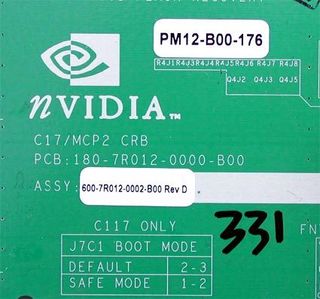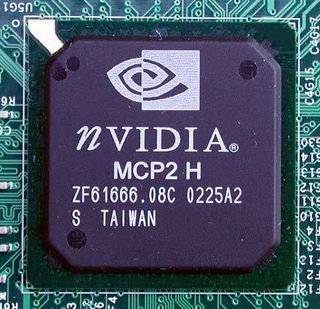AMD Travels Through Time: Athlon XP 2800+ with Dual-DDR
Bingo! Synchronous Operation With 166 MHz FSB, Continued
Because the two buses (FSB and memory) ran asynchronously, even DDR333 memory with CL2.0 could not achieve optimal performance. Now, eight months after the introduction of the VIA KT333, it is finally possible to clock the CPU and RAM synchronously and attain maximum system performance.
The next step in the evolution has already been determined: boards for DDR 400 (KT400) that work with 200 MHz memory clock can only communicate asynchronously with the newest Athlon XP processors. So, a further increase in FSB clock speed is planned.

The reference board from Nvidia with the nForce 2 chipset. During the test, it did not run error-free.

Northbridge of the nForce 2 chipset.

Southbridge of the nForce 2 chipset.
Ultimately, there's still some distance between the Athlon XP and its arch rival, the Intel Pentium 4: the latter offers a bandwidth of 4.2 GB/s at an FSB clock of 133 MHz - together with RDRAM PC1066 (533 MHz), synchronous operation is possible (4.2 GB/s).
Stay On the Cutting Edge: Get the Tom's Hardware Newsletter
Join the experts who read Tom's Hardware for the inside track on enthusiast PC tech news — and have for over 25 years. We'll send breaking news and in-depth reviews of CPUs, GPUs, AI, maker hardware and more straight to your inbox.
Current page: Bingo! Synchronous Operation With 166 MHz FSB, Continued
Prev Page Comparison: Heat Dissipation Of All AMD Athlon CPUs Next Page Details On The Test BoardsMost Popular



